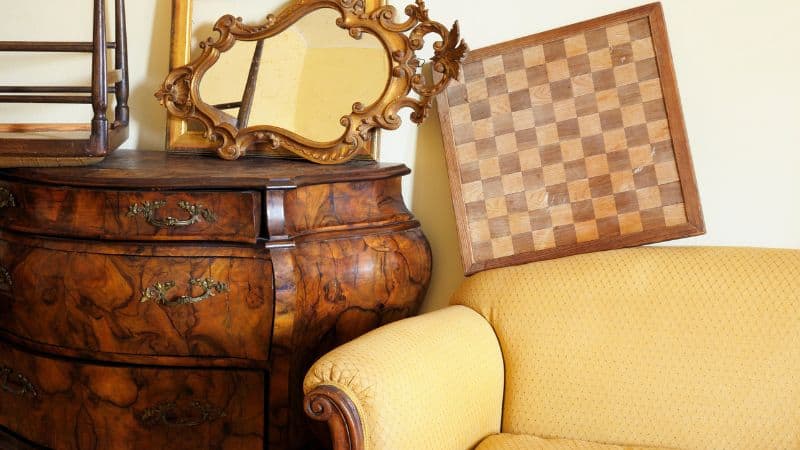
When you hear the words antique and vintage, you might think they mean the same thing, but actually they do not. Usually, vintage items are much younger than antique items.
You could be looking at old furniture, clothing, or collectibles, and calling them either antique or vintage without knowing the real meaning. This can affect how you price or care for the item. By learning the age and origin of your piece, you get a clearer picture of its background and significance.
Defining Antique Items
Antique items are objects that are at least 100 years old. This age mark is widely accepted by collectors, auction houses, and customs agencies. When you find an item that meets this age, it qualifies as an antique. Some sellers might label items over 50 years old as antiques, but serious collectors stick to the 100-year rule to maintain quality and value.
You should know that antiques usually have higher value because of their age, rarity, and historical importance. These items usually show styles and craftsmanship that you won’t see in modern objects. They reflect the culture and technology of the time they were made. Many antique pieces are handmade or made with materials no longer common today.
Some common examples of antiques include:
- Furniture made before the 1920s
- Jewelry with classic designs from past centuries
- Old books or documents over 100 years old
Defining Vintage Items
Vintage items are typically those that are between 20 and 100 years old. This means if you find something made in the 1950s or 1970s, it is likely considered vintage.
Vintage pieces are not as old as antiques, but they still have value because they also reflect the style and culture of the time they were made. You can think of vintage as a way to capture a specific era, whether it’s fashion, furniture, or collectibles. You might find a vintage item that reminds you of a past decade or has a unique look no longer made today.
Here are some quick points to remember about vintage items:
- Usually less than 100 years old
- Reflect the style of a specific past era
- Can be collectible for their look or uniqueness
- Not yet old enough to be antiques
Defining Retro Items
Retro items are objects designed to look like they come from past decades but are newer or reproductions. These usually reflect the trends from the 1960s to the early 2000s. When you see bright colors, bold patterns, or quirky designs, you might be looking at something retro.
Unlike antiques or vintage items, retro pieces are not old in age. You can think of retro as a style choice, not an age category. It’s about bringing past looks into modern life. This means you can find retro items that look vintage but aren’t actually old. This makes retro popular for those who like nostalgia without needing real old items.
Here are some key points to identify retro items:
- Made recently but designed in an older style
- Often imitate styles from 60s, 70s, 80s, 90s, or early 2000s
- Can be found in furniture, clothes, decor, and gadgets
- Usually less valuable than true antiques or vintage pieces
Antique vs Vintage: Key Differences
To understand the difference between antique and vintage items, age is the main factor to consider. An item is usually called an antique if it is at least 100 years old. In contrast, vintage refers to items that are typically between 20 and 100 years old.
They also have different connotations and essences. Antique implies rarity, history, and craftsmanship. The word carries a sense of importance, formality, and often, high value. An antique item is valued for its historical narrative. Meanwhile, vintage implies style, nostalgia, and cyclical trends. The word is inherently tied to fashion and pop culture. A vintage item is valued for its aesthetic, its ability to evoke a specific period’s feeling.
The primary sources of value differ significantly between the two categories. An antique item’s value is driven by historical significance, provenance, authenticity, and the quality of materials and craftsmanship. However, a vintage item’s value is driven by aesthetic appeal, collectability, brand name, and current trends. For example, an antique desk is valuable because it’s a genuine, hand-crafted Queen Anne piece from the 1700s. Whereas a vintage 1980s band t-shirt is valuable not because of its historical importance, but because of the band’s logo, the graphic design, and its desirability within a specific subculture.
In addition, they serve different functions and uses. Antique is often treated as decorative art or a preservation piece. While many antiques are still functional, they are frequently handled with care, conserved, and displayed. Conversely, vintage is often used and worn as a functional part of modern life. Vintage clothing is worn to parties, and vintage cars are driven on weekends.
| Feature | Antique | Vintage |
|---|---|---|
| Core Idea | Historical artifact | Retro style |
| Value Driver | Provenance, craftsmanship, history | Aesthetics, nostalgia, brand |
| Connotation | Formal, rare, museum-quality | Cool, nostalgic, trendy |
| Typical Use | Display, preservation, careful use | Active use and wear |
| Example Mindset | “This is a priceless piece of history.” | “This has such amazing character and style!” |
Knowing these differences helps you identify and understand your items better. It also guides you in making smart choices when buying or collecting.
Typical Examples of Antique and Vintage Pieces
- Furniture (Chippendale, Empire)
- fine art (oil paintings, sculptures)
- porcelain (Chinese export porcelain, Meissen)
- jewelry (Victorian, Art Nouveau)
- ancient artifacts
- Clothing (1950s poodle skirts, 1970s platform shoes)
- accessories (1980s costume jewelry)
- electronics (1980s boomboxes, vintage Apple computers)
- cars (pre-1990s models)
- mid-century modern furniture
Knowing these notable examples can help you decide whether an item is antique or vintage. This knowledge is useful when buying, collecting, or decorating with these pieces.
FAQs
How many years does it take for an item to be classified as antique or vintage?
An item must be at least 100 years old to be considered an antique. And an item is classified as vintage when it is between 20 and 99 years old. Vintage items are younger than antiques but still have historical or nostalgic appeal.
What distinguishes a vintage car from a classic car?
Vintage cars are typically from a defined period, usually made between the 1910s and late 1930s. Classic cars are often older than 20 years but don’t fit into the antique or vintage categories strictly. The terms are related but not interchangeable, and rules can vary by car clubs or regions.
How is the term retro defined in relation to vintage and antique items?
Retro refers to new items designed to imitate styles from the past. Unlike vintage or antique, retro is about reproducing old looks rather than representing genuine age. Retro objects may look old but are recently made.
What factors contribute to an item being categorized as either antique or vintage?
Age is the main factor, but historical significance, style, and craftsmanship also matter. Condition and provenance can influence the classification and value. Marketing can blur these lines, but strict age thresholds define the categories.
How do preservation and restoration approaches differ between antique and vintage items?
For antiques, the primary goal is often preservation and conservation. The focus is on stabilizing the item to prevent further deterioration while retaining as much of the original material and patina as possible. For vintage items, restoration is often more acceptable and focused on returning the item to a functional or aesthetically pleasing state.






